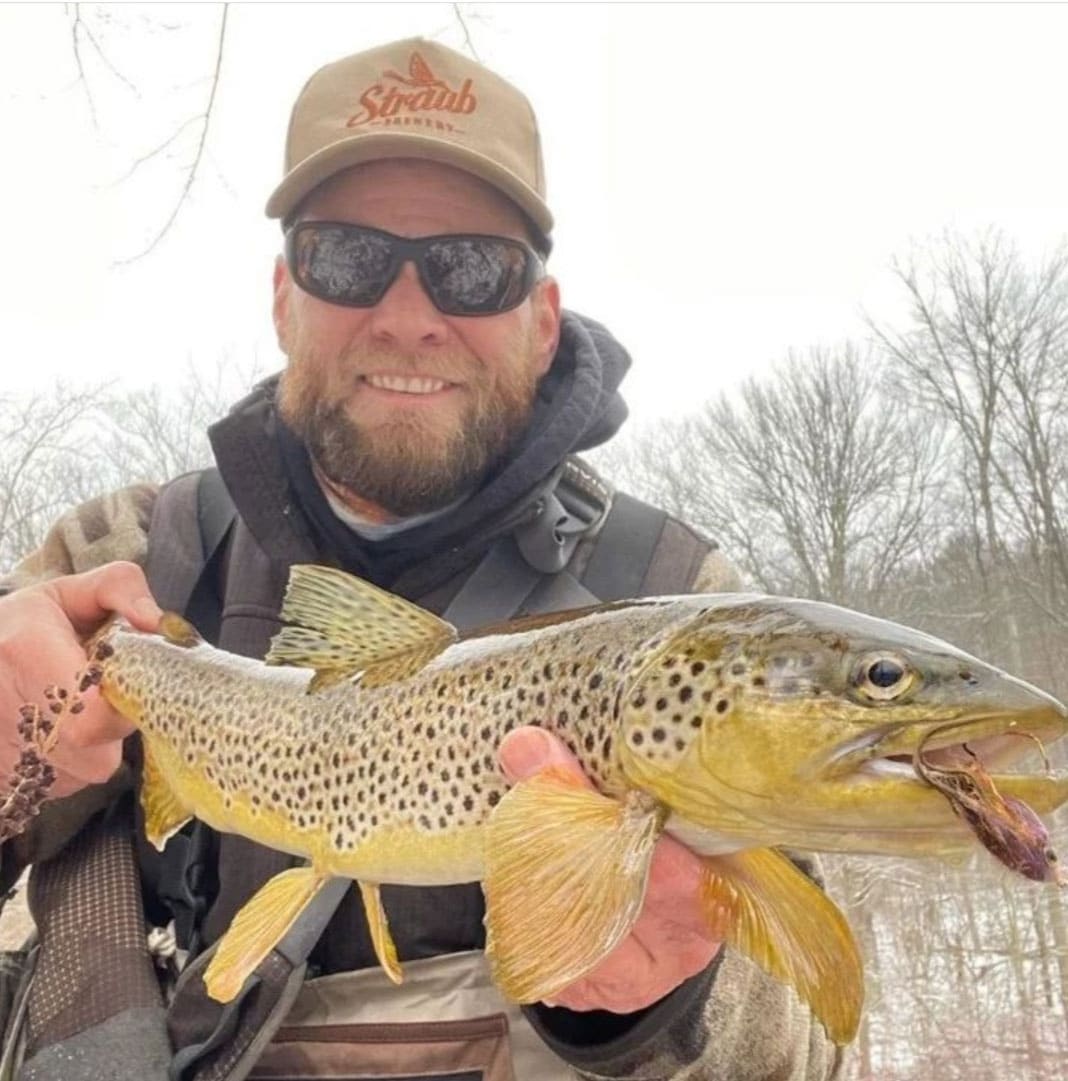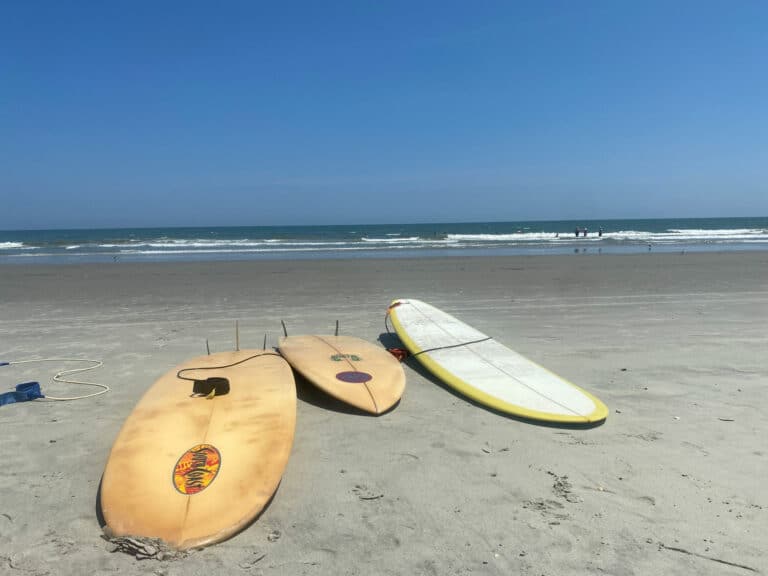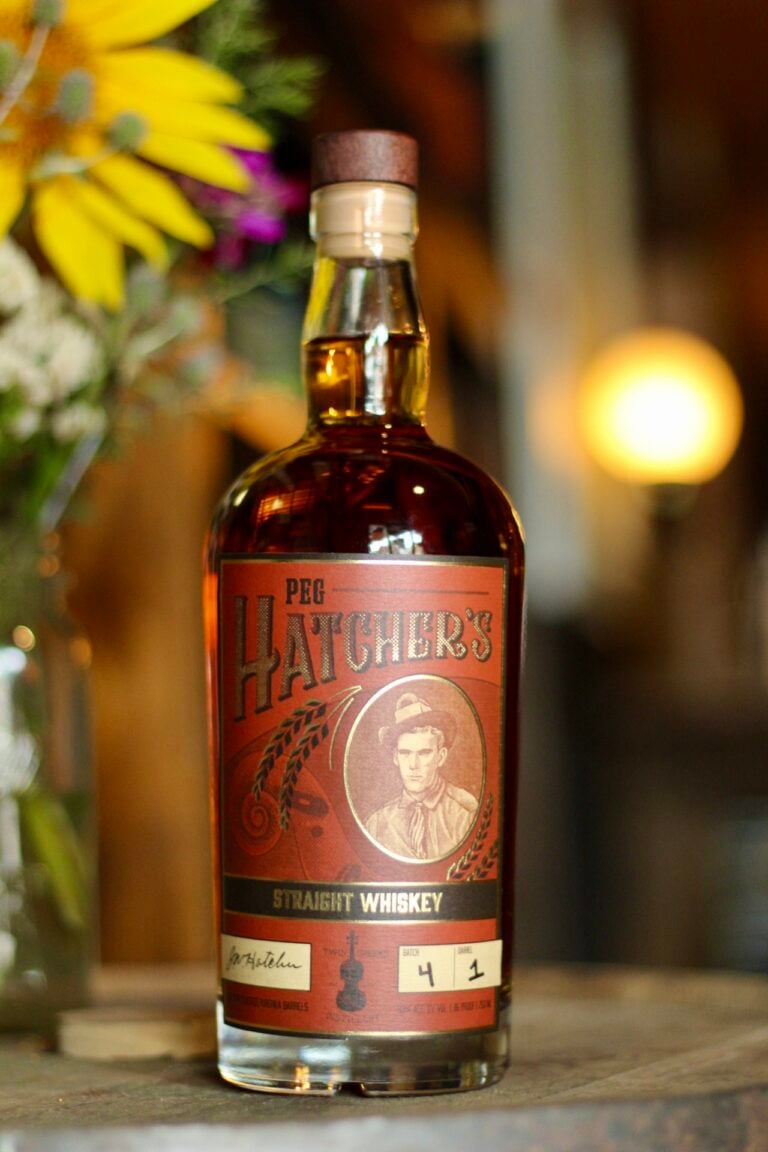Trout Guides Give Up Their Confidence Patterns
One-fly challenges are fly fishing tournaments that limit anglers to a single fly they select prior to competition. It’s an interesting concept. Fly fishing, at its core, is a practice of observation and adjustment on the water. Fishing just one fly throws all of that out the window.
There’s a reason most fly fishers carry numerous fly boxes with hundreds of flies in dozens of different colors and patterns. It’s the same reason our packs are stuffed with the tools and materials to switch rigs quickly and cover the entire water column in different ways. The best anglers observe what’s going on around them and continually adapt. Solving the riddle of what and how the fish are eating at a given moment is intrinsic to the sport, and it changes continually based on a host of factors.
In a one-fly challenge, the angler is tasked with making an educated guess and sticking with it. If the fish aren’t eating what you’re throwing, you’re in for a long day. Lose that one fly, and you’re done.
Still, we all have our confidence rigs. This is what you tie on at the truck before walking down to the river to begin fishing. So BRO decided to survey guides from around the region to ask them what they would tie on if they could only fish one fly for trout this spring. The result is a good list of productive flies for springtime casting across the Blue Ridge. Use it as a shopping list, and you’ll be ready to adjust on the water and catch trout wherever you are in whatever conditions.
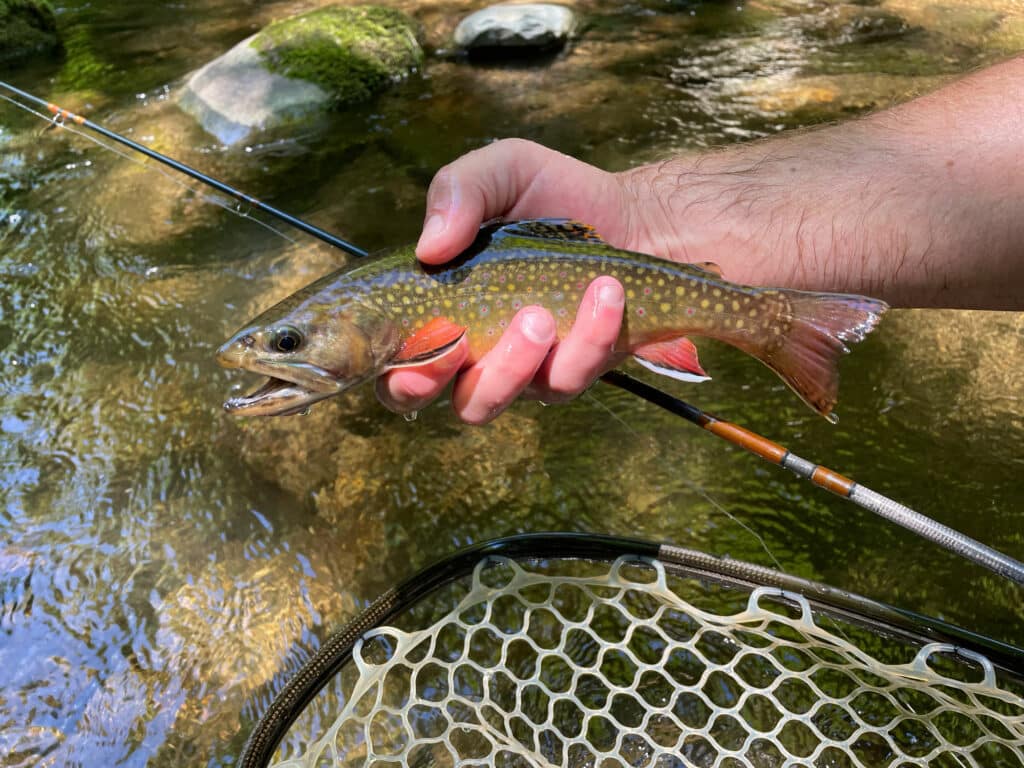
Parachute Adams
Dane Law, with Southeastern Anglers, instantly knew his answer.
“Parachute Adams,” he said. “It’s not one particular thing; it represents a little bit of everything that’s buggy in the spring. It’s a caddis. It’s a mayfly. It’s an ant or any little bug that’s fallen in the water.”
Spring means dry flies to many anglers, and the Parachute Adams is a classic dry fly that’s a variation on the even more classic Adams. Classics become classic because they work.
The first Adams was tied by Leonard Halladay as a general mayfly imitation in 1922, according to fishing historian Paul Schullery. Halladay tied the fly for his buddy Charles Adams (hence the name), who first fished it successfully on Michigan’s Boardman River. Since then, it has become a staple in just about every dry fly angler’s box, regardless of where they fish.
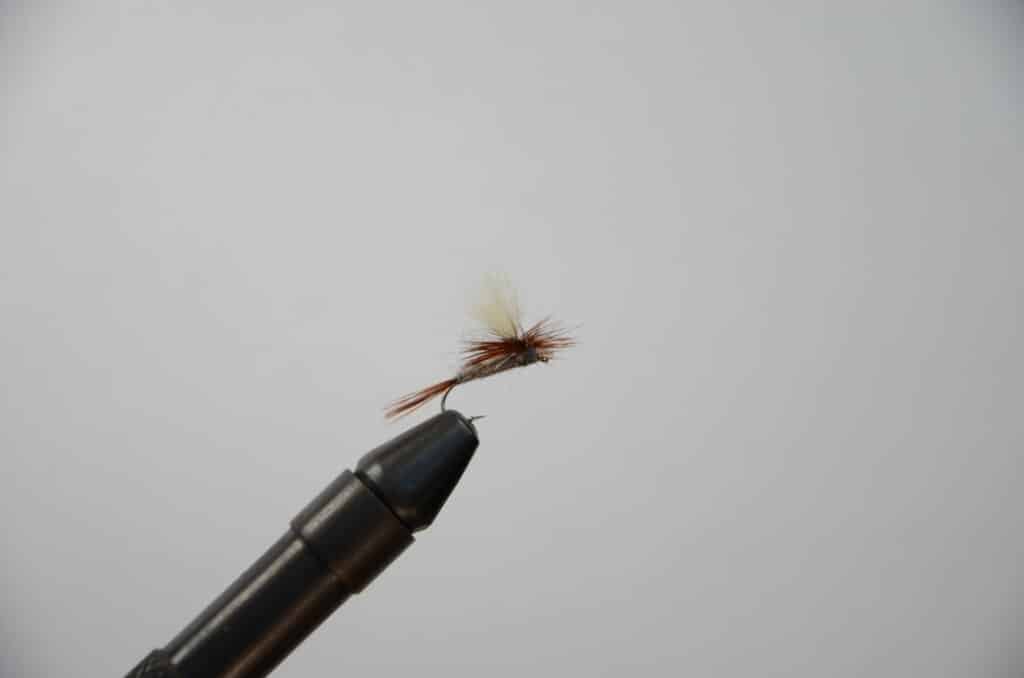
Springtime brings the emergence of many insect hatches, especially on the region’s high-elevation freestones. A Parachute Adams (left) is a general mayfly pattern that imitates a wide range of spring insects. Photos by Nick Carter.
Southeastern Anglers primarily guides on the Hiwassee in Tennessee and the Cumberland in Kentucky, but Law said he’d choose a Parachute Adams anywhere, from big rivers to small headwaters.
“It’ll work anywhere in spring,” he said. “I was in Patagonia last year in the season I equate with spring down there, and I was drifting an Adams in an eddy pool.”
The Parachute Adams is dark gray with a hackle wrapped horizontally around a vertical post near the head of the fly. Its body sits in the surface film below a leggy-looking halo of feather. It’s intended to mimic any mayfly, and it does that well in different sizes, but its profile is just downright buggy. It could be any bug, and hungry trout can’t resist eating it.
The parachute—the vertical tuft of white calf’s hair—is highly visible, which makes it an enjoyable dry fly to fish, especially in small sizes, low light, or rough water where it’s difficult to track your drift.
www.southeasternanglers.com; (770) 655-9210
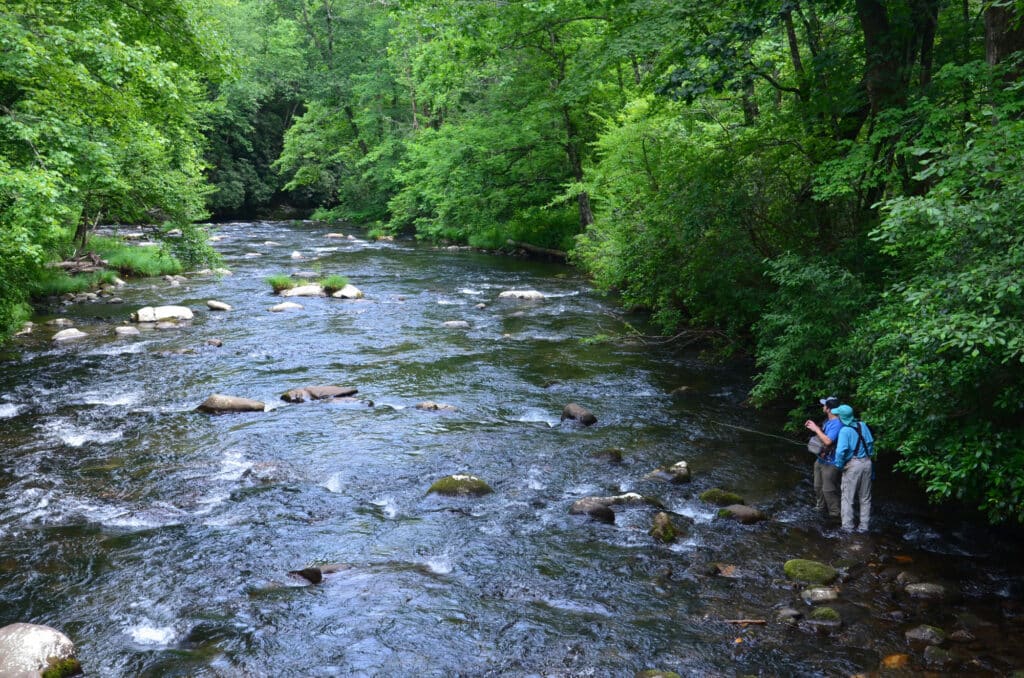
Mini Sex Dungeon
When spring rains bring high water to Pennsylvania’s Clarion River, Don Cameroni, of Brown Trout Addiction, will be out there chucking streamers. His favorite may be Kelly Galloup’s Mini Sex Dungeon.
“Browns are a predator fish,” he said, “and the way it moves imitates a good baitfish.”
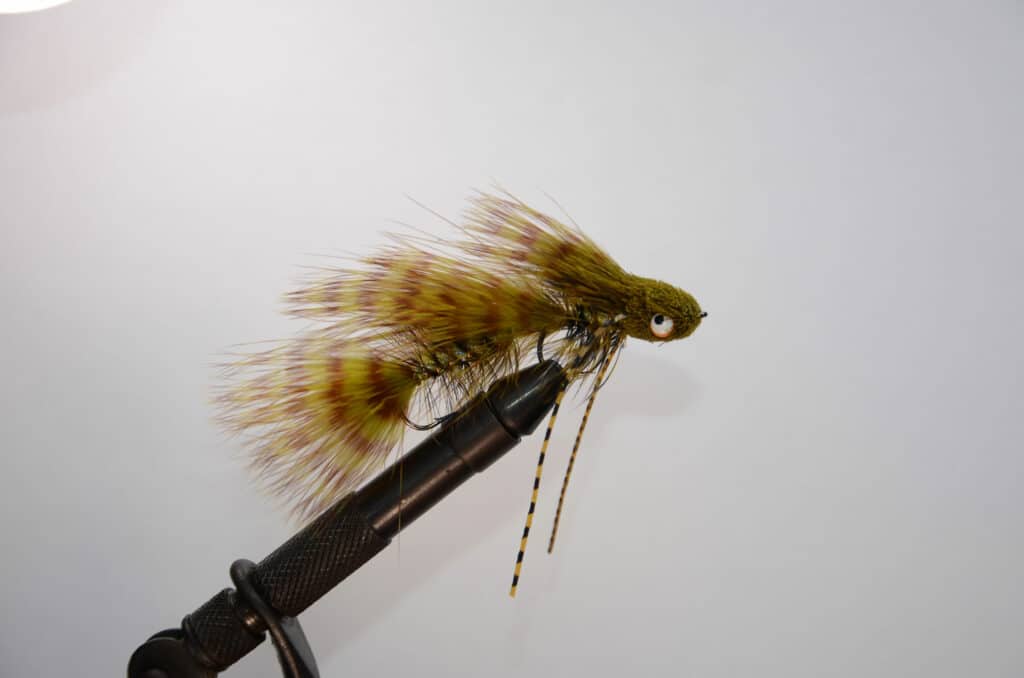
Baitfish—like chubs, fatheads, and shiners—are what big brown trout eat to fatten up after the rigors of the fall spawn. Cameroni said they “put their belly back around the middle of March,” and it’s due to a high-protein diet of smaller fish.
While nymph rigs usually get the nod on low water, when fish are more nocturnal and skittish, Cameroni breaks out his streamer box on high water, especially for two or three days of falling water after a heavy rain, when he said the fishing can be crazy good. His box is full of Galloup patterns, and in the right conditions they produce his largest trout of the year.
The Mini Sex Dungeon is a 2.5-inch version of the original Sex Dungeon, which can be tied to 4.5 inches or longer. Be sure to include the term “streamer” if you Google it. Like all Galloup streamers, the Mini Sex Dungeon is designed to swim. It’s an articulated fly, meaning it uses two loosely connected hooks to form a segmented body that snakes through the water on retrieve. Honed over a decades-long obsession with streamer fishing, Galloup’s flies and tactics offer good ways to get the attention of the largest trout in the river, and Cameroni is hunting browns in the mid- to high-20-inch range.
www.browntroutaddiction.com; (814) 512-7891

Sob-Czech, Olive
The effectiveness of Euro nymphing has taught a lot of fly fishers that putting a fly on a fish’s nose with a natural-looking drift is far more important than matching any particular hatch when it comes to nymphing. A heavy jig-style nymph sinks into the strike zone quickly, and if it looks buggy there’s a good chance a trout will eat it.
Ernie King, of Fish Tales Outfitters, said he doesn’t really know what the Sob-Czech is supposed to mimic. “It just works,” he said.
“It’s nothing fancy, just a hook with some dubbing and thread and a pink collar,” he said. “It’s a very simple fly and it works. It’s my No. 1 selling fly through spring up to early summer.”
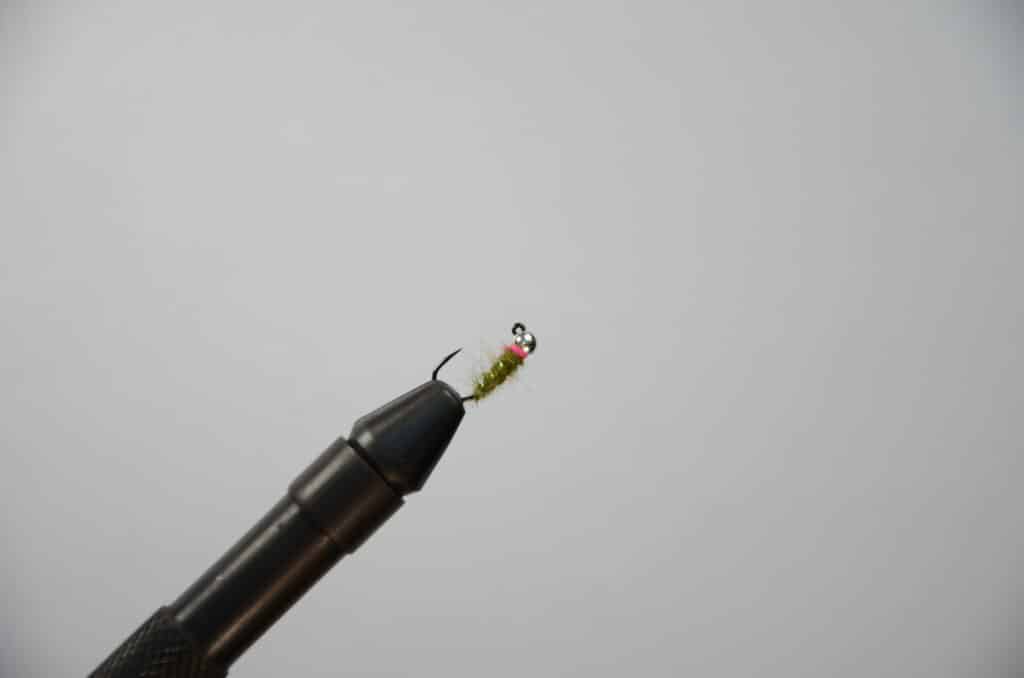
Online descriptions of this nymph say it mimics grubs and larvae without indicating exactly what aquatic insect it’s imitating. In the mountains of western North Carolina, where King does most of his trout fishing, an olive-colored body is the ticket, perhaps because blue-winged olive mayflies are prevalent in all stages of life in spring. The bright pink collar is what fly tyers call a “hot spot.” Its purpose is to catch a fish’s eye to lure it in for closer inspection of the buggy-looking body.
King said he enjoys fishing a blue-winged olive dry fly in spring, but when he wants to catch good numbers of fish, he nymphs. In sizes 14 to 18, a Sob-Czech is very versatile. It works for stocked trout as well as wild fish, and it’s a go-to pattern on popular delayed-harvest fisheries.
On the larger Cullasaja or Nantahala tailraces, it can be fished deep or shallow as part of a long Euro-nymph rig. On small higher elevation streams or in Great Smoky Mountains National Park, it can be fished under an indicator or as a dropper, and it’s deadly when tightlined through short, fast runs.
www.fishtaleswnc.com; (828) 421-0732
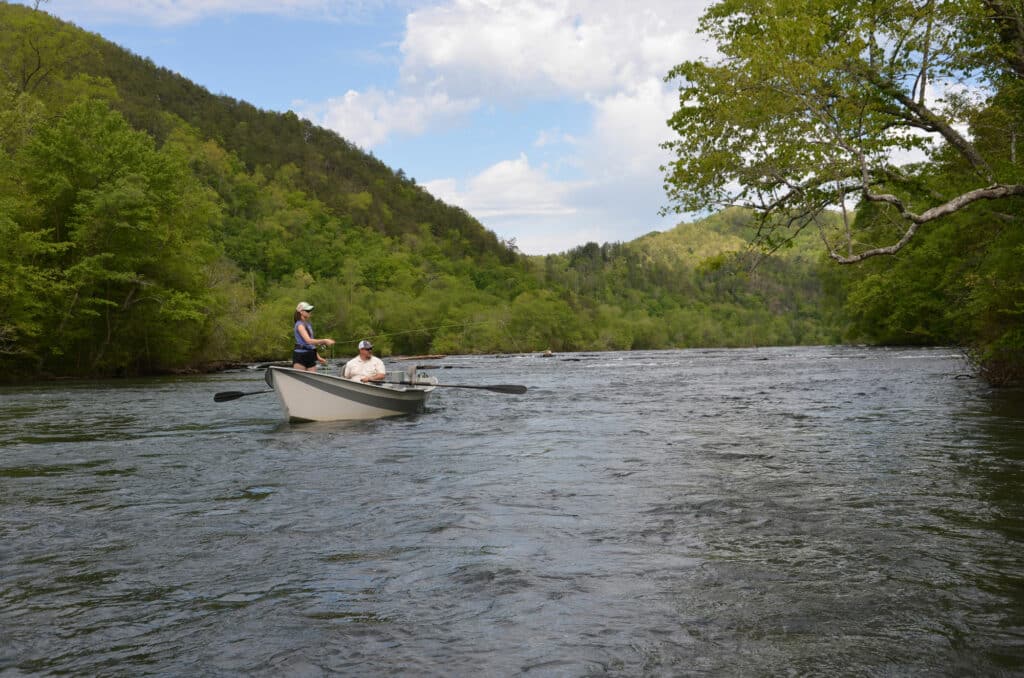
CDC Pheasant Tail Jig Nymph
The Pheasant Tail Nymph is one of those iconic flies that’s spawned new variations from fly tyers for more than a century. The variation Nick Seacrist fishes most in spring is a jig-style Pheasant Tail, and it has all the bells and whistles.
Seacrist guides with Mossy Creek Fly Fishing in Harrisonburg, Va. Shenandoah spring creeks are his home waters.
“When that thing gets wet, it just looks like so many aquatic insects that it works anywhere,” he said. “And with that jig-style hook, it gets down quick without hanging up on the bottom as much.”
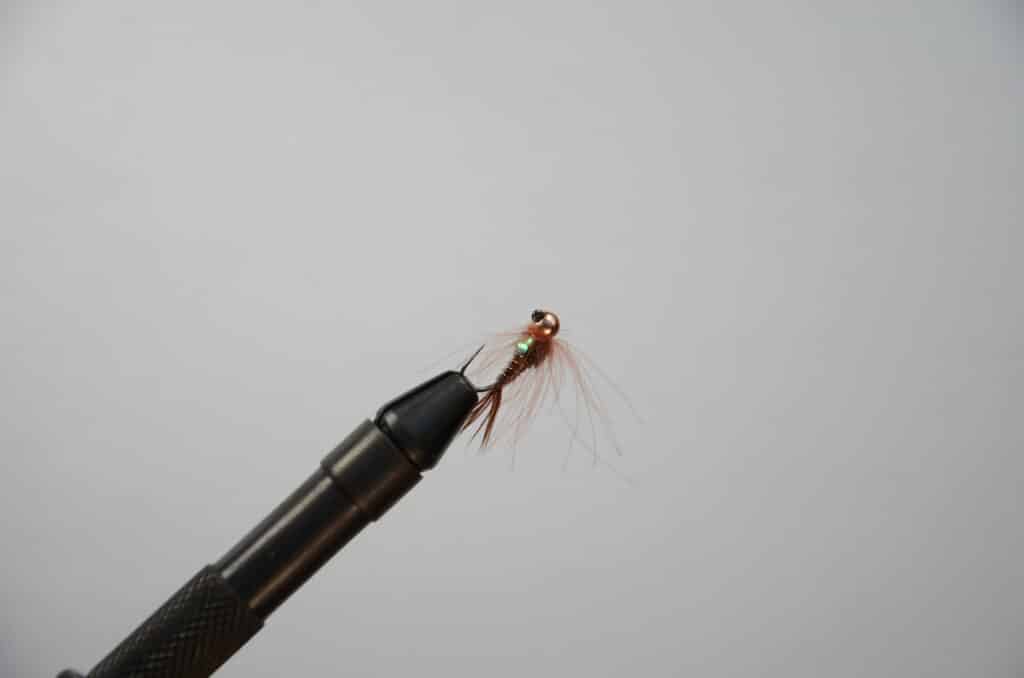
The Hot Orange Bead Jig CDC Pheasant Tail Seacrist prefers for brook trout bears about as much resemblance to the original Pheasant Tail as the name does. The original—developed by English chalk stream angler Frank Sawyer at the advent of modern nymphing—was simply pheasant tail fibers, copper wire, and a hook.
The version Seacrist fishes for brookies has a bright orange tungsten bead on a 90-degree jig hook. Along with the pheasant tail and copper wire, this fly features a soft hackle collar and a little bit of flash to draw attention. Brookies are notorious suckers for bright and flashy patterns. They must feed opportunistically in the relatively sterile high-elevation streams where they live.
For rainbows and browns, Seacrist is more likely to fish a standard CDC Pheasant Tail Jig Nymph. It’s the same as the “hot head” version except the tungsten head is copper-colored instead of orange.
Both nymphs sink quickly in the short runs of Virginia spring creeks. The jig-style head forces the hook point to ride upward in the water, which means it can be fished along the bottom of a stream without hanging up as much as a traditional-style bead head nymph.
Mossycreekflyfishing.com; (540) 434-2444
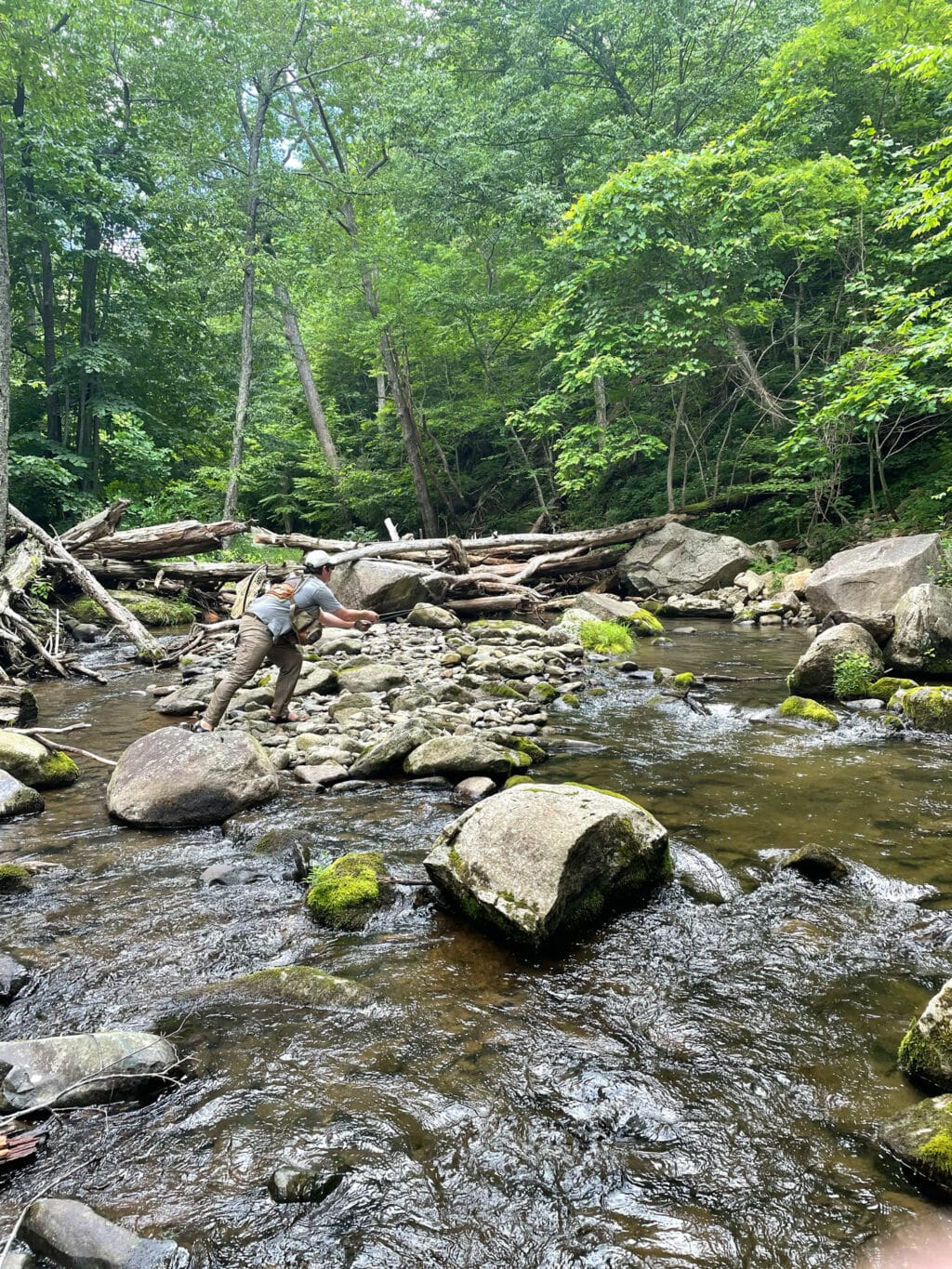
Walt’s Worm
Easy-to-tie flies can be the best flies, especially for guides who spend hours tying only to watch clients decorate the trees with their labors. Walt’s Worm just might be the world’s best guide fly. It’s an extremely effective nymph pattern that’s inexpensive to tie and can be whipped out by the dozen in short order.
Brian Largent, of Precision Fly and Tackle in Mount Holly Springs, Pa., said you can catch fish anywhere in springtime with a handful of Walt’s Worms and Pheasant Tails. He primarily fishes freestone streams for wild brown trout but said Walt’s Worm catches trout wherever they swim.
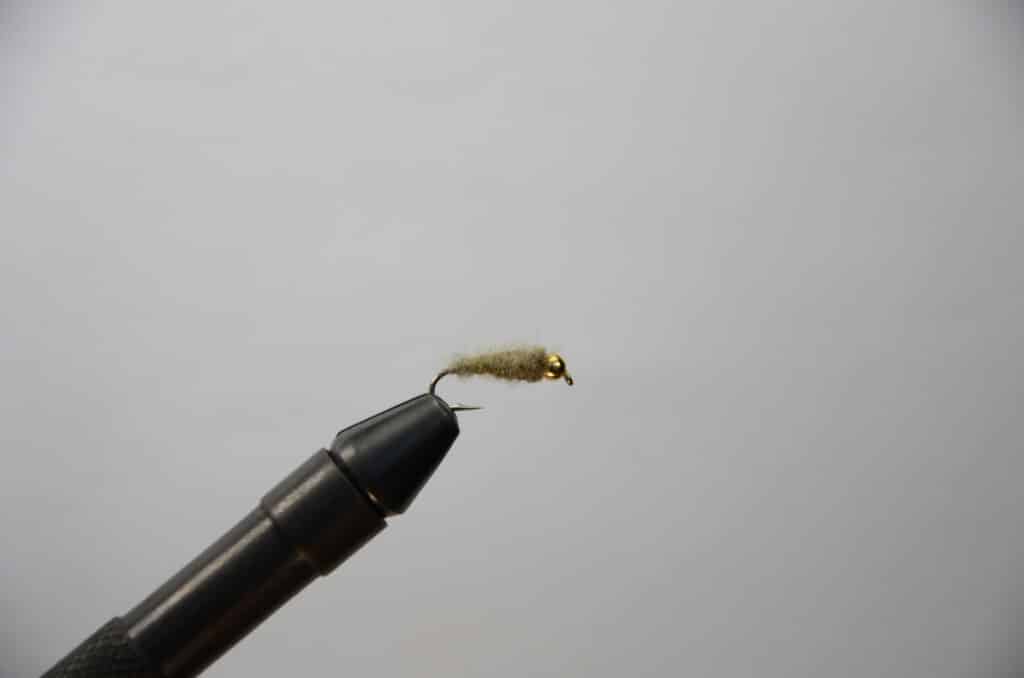
“There’s a lot of bugs hatching in spring, and it’s a very general pattern that imitates a lot of them,” he said. “It’ll work just about anywhere you take it. If there are trout in the water, it will work.”
Pennsylvania tyer Walt Young developed Walt’s Worm in the 1980s to mimic crane fly larvae for his home state’s famed spring creeks. However, these waters are loaded with vegetation that’s home to all sorts of aquatic life. Walt’s Worm is so simple and so general that it could represent a range of edible subsurface critters to a trout, whether it’s a scud, shrimp, caddis, mayfly, or cress bug.
“It’s a simplified version of a Hare’s Ear,” said Largent. “It catches fish, and it’s very easy to tie.”
Walt’s Worm can be tied with or without a bead head and with or without a few wraps of lead-free wire. From there, it’s nothing more than some Hare’s Ear dubbing wrapped around a hook.
Precisionflyandtackle.com; (717) 486-4646
Elk Hair Caddis, Tan
The Elk Hair Caddis is another classic pattern that was developed in Pennsylvania. It catches trout anywhere you take it. It was first tied in the 1950s by Al Troth, and it mimics a caddisfly, one of spring’s primary food sources for trout.
Jeff Durniak, of Unicoi Outfitters in the north Georgia mountains, said he would choose a size 16 tan Elk Hair Caddis if he had to choose one dry fly for spring. He said they get a lot of caddis hatches in April and May, and that it also works very well as an attractor pattern even when there isn’t a hatch occurring.
The thing about caddisflies is there’s likely to be one species or another popping off sporadically or in a full-fledged hatch at different times of day throughout spring. Even when there aren’t real bugs on the water, trout in most streams and rivers are tuned to look for caddisflies.
There are also a lot of different ways to fish an Elk Hair Caddis.
“Try dead drifting, but if that doesn’t work, try casting it downstream and skitter it,” Durniak said.
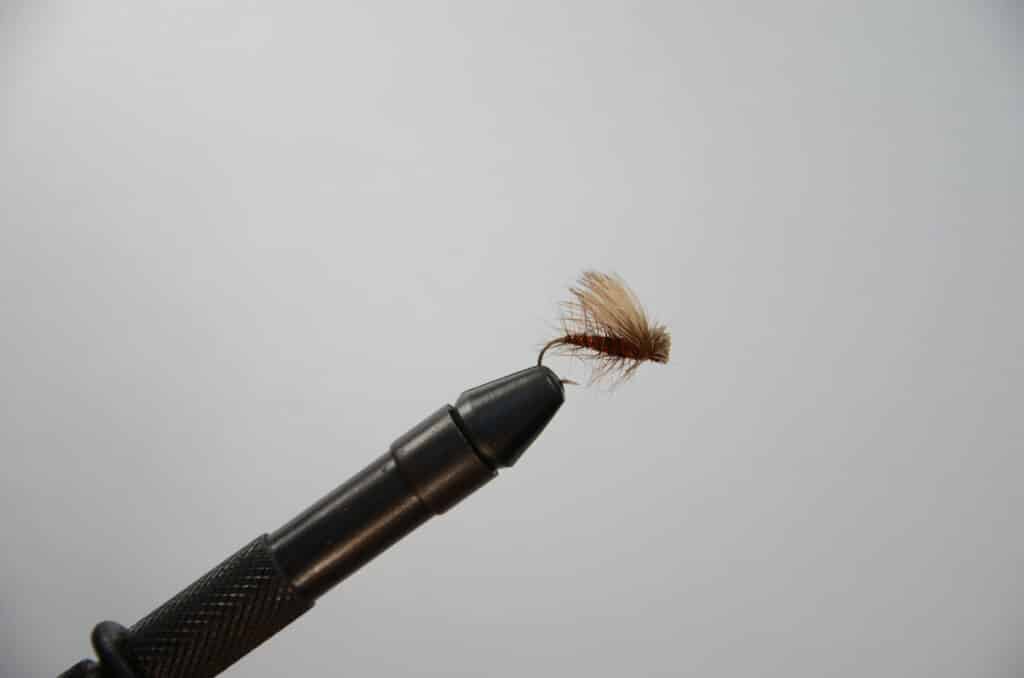
Mature caddisflies bounce around on the surface when they’re trying to break through the surface film to lay eggs. Durniak said seeing this activity should prompt you to give your fly a little action. “Skitter it and let it drop, skitter it and let it drop,” he said. The technique is one of the few times you’ll ever “work” a dry fly for trout. Lift your rod tip and wiggle it to make the caddis skitter across the surface. Then drop the line on the water and let it drift briefly before skittering it again.
An Elk Hair Caddis also floats like a cork, so it’s easy to see, and it works very well as what Durniak called an “indicator with a hook in it.” Drop a nymph below an Elk Hair Caddis for a deadly dry-dropper rig in shallower streams or shallow riffles. Or fish it in tandem with a second dry fly. You give the fish two different options, and the big, flared, elk hair wing is easy to spot on the drift. It can help you keep track of where your second fly is.
www.unicoioutfitters.com; (706) 878-3083
Nick Carter is author of “Flyfisher’s Guide to North Carolina & Georgia.” It is available on Amazon or by contacting the author at [email protected].
Cover photo: Don Cameroni, of Brown Trout Addiction, fishes articulated streamers for big brown trout on Pennsylvania’s Clarion River. He catches his largest trout stripping Kelly Galloup patterns during high waters after heavy spring rains. Photo courtesy of Don Cameroni.
Cover photo: Don Cameroni, of Brown Trout Addiction, fishes articulated streamers for big brown trout on Pennsylvania’s Clarion River. He catches his largest trout stripping Kelly Galloup patterns during high waters after heavy spring rains. Photo courtesy of Don Cameroni
